#Messiaen transfiguration
Explore tagged Tumblr posts
Text
#this is more like a conversation starter than a poll bc no way am i putting all the good options on here#like first of all theres like 6 really good contenders that are mahler alone lmao#evocation polls
141 notes
·
View notes
Text
I didn't anticipate that it would sound like Messiaen's Transfiguration, at all
listened to Al gran sole carico d'amore not anticipating that my romance would prove, indeed, fleeting as the Commune of 1871... and its spirit also continues just the same...
2 notes
·
View notes
Video
youtube
Messiaen - La Transfiguration de Notre-Seigneur Jésus-Christ (1969)
Today is the Western Christian feast day of the Transfiguration, a miracle in the Gospels where Jesus led some of the disciples up a mountain to pray, only for him to become luminous, be situated between Elijah and Moses, and a voice from the heavens calls Jesus the Son. The Trinity revealed, as well as a glimpse of how humans will be at the end of time. This is a very...esoteric story, and more theologically packed than many of the Christian stories that are easier to get from surface level hearing. It only makes sense that Messiaen would be drawn to this moment in the Gospel to work through its Mystic implications. But the combination of overt Christian Mysticism, the gargantuan orchestral ensemble, and the length of the work, have all come together to keep this piece from being performed more often. Which is a shame because, musically, it has some of the best aspects of Messiaen’s style, along with inventive and colorful writing. The work is divided into two parts of seven pieces each, and it is unified by and oriented around the opening three note phrase on gongs. At four points, lines from the gospel are sung in a homophonic plainchant style, each time announced by the gongs which, along with the use of added percussion, evoke a sense of Eastern mystery. The choruses use quotes from Aquinas, elevating the dry language through Mediterranean and Indian rhythms, decorated with birdsong, and of course, dense rich harmonies. Even if you aren’t Christian, you can love the music, and I’d recommend listening to it on a long hike through a forest preserve.
Movements:
First Septenary
I. Récit évangélique (Gospel)
II. Configuratum corpori claritatis suae (To be like his glorified body)
III. Christus Jesus, splendor Patris (Jesus, reflection of the Father)
IV. Récit évangélique (Gospel)
V. Quam dilecta tabernacula tua (How lovely are your tabernacles)
VI. Candor est lucis aeternae (She is the reflection of eternal light)
VII. Choral de la sainte montagne (Chorale of the holy mountain)
Second Septenary
VIII. Récit évangélique (Gospel)
IX. Perfecte conscius perfectae generationis (Perfectly conscious of that perfect generation)
X. Adoptionem filiorum perfectam (The perfect adoption of sons)
XI. Récit évangélique (Gospel)
XII. Terribilis est locus iste (How awesome is this place)
XIII. Tota Trinitas apparuit (The whole Trinity appeared)
XIV. Choral de la lumière de gloire (Chorale of the light of glory)
#Messiaen#transfiguration#music#classical#classical music#orchestra#choir#choral music#orchestra music#20th century music#sacred#sacred music#oratorio#la transfiguration de notre seigneur jesus christ#the transfiguration of our lord jesus christ#Jesus#Messiaen transfiguration#Messiaen la transfiguration de notre seigneur jesus christ#Olivier Messiaen
22 notes
·
View notes
Text
27 DE ABRIL DE 2023 : DEPOIS DE WAGNER HOJE O CONSOLO FOI DE MESSIEN NA GULBENKIAN OUVINDO A TRANSIGURATION DE NOTRE SEIGNEUR JESUS-CHRIST » OBRA PARA CORO MISTO , SETE SOLISTAS INSTRUMENTAIS E GRANDE ORQUESTRA .FOI INTERPRETADA POR 2 “ MISSIONÁRIOS “ - O MAESTRO MYUNG -WHUN CHANG E O PIANISTA ROGER MURARO ! :ao dia 52 da ausência absurda ao fim da tarde cumpri a “nossa “ assinatura procurando um o consolo de Messien . A origem desta obra transcendente
está numa encomenda feita a Messiaen, a 9 de junho de 1965, por Madalena de Azeredo Perdigão (1923-1989), diretora do Serviço de Música da Fundação Calouste Gulbenkian Considerada por Messiaen como“a mais substancial de todas as obras
que compus,, La Transfiguration constrói uma síntese das obras anteriores: »o pendor meditativo do Quatuor pour
la fin du temps (1941), a fluidez coral de Cinq Rechants (1948), o ímpeto orquestral da sinfonia Turangalîla (1948) e a vivacidade da percussão do Sept Haïkaï (1962). Igualmente, enquanto consumado ornitologista, Messiaen utilizou o chilrear de pássaros dos cinco continentes como motivos melódico-rítmicos
que pontuam toda a composição ». Foi um dos melhores concertos da temporada e doeu estar vazia a cadeira 11 da fila 27. A profunda melomana que foi a Maria Zaza teria adorado esta obra maior da música do século XX .
12. Terribilis est locus iste
« C’est en regardant, par temps clair, le Mont Blanc, la Jungfrau, et les trois glaciers de La Meije en Oisans, que j’ai compris la différence entre la petite splendeur de la neige et la grande splendeur du soleil – c’est là aussi que j’ai pu imaginer à quel point le lieu de la Transfiguration était terrible !... La terreur sacrée est rendue par les sons pédales des trombones et les « clusters » trillés dans le grave. Le décor est donné par les cris des oiseaux de montagne : Faucon pèlerin, Aigle de Bonelli. La lumière des « hauteurs » apparaît dans les accords de Bois et Cuivres passant subitement au pianissimo des sons harmoniques de violons : dans cette blancheur surnaturelle frémissent les pizzi des violoncelles et les couleurs d’accords du piano, des cloches, des crotales. Une vocalise collective écrite à vingt parties réelles amène le mot final : “Terribilis”. »
Terrível e o que estou a viver
Coro e Orquestra Gulbenkian
Myung-Whun Chung Maestro
Roger Muraro Piano
Sónia Pais Flauta
Iva Barbosa Clarinete
Varoujan Bartikian Violoncelo
Nuno Simões Marimba
Marco Fernandes Vibrafone
Bruno Costa Xilofone
Jorge Matta e Inês Tavares Lopes Maestros do Coro Gulbenkian Olivier Messiaen
La Transfiguration de Notre Seigneur Jésus-Christ
PREMIER SEPTÉNAIRE
1. Récit évangélique
2. Configuratum corpori claritatis suae
3. Christus Jesus, splendor Patris
4. Récit évangélique
5. Quam dilecta tabernacula tua
6. Candor est lucis aeternae
7. Choral de la Sainte Montagne
I
DEUXIÈME SEPTÉNAIRE
8. Récit évangélique
9. Perfecte conscius illius perfectae generationis
I0. Adoptionem filiorum perfectam
II. Récit évangélique
I2. Terribilis est locus iste
I3. Tota Trinitas apparuit
I4. Choral de la lumière de Gloire



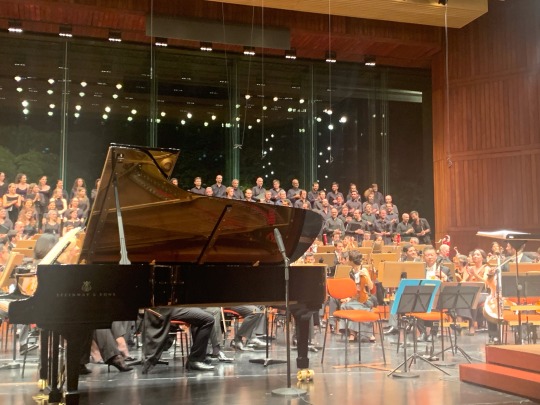
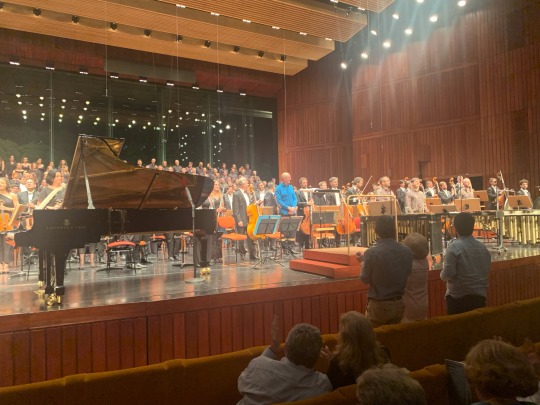

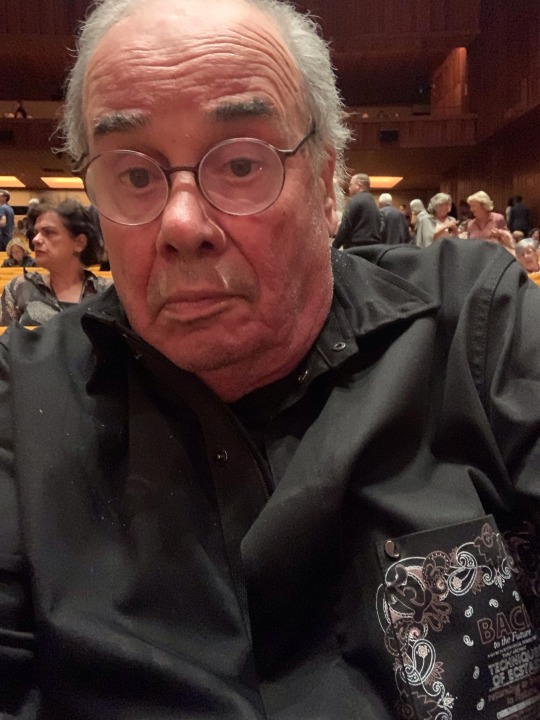
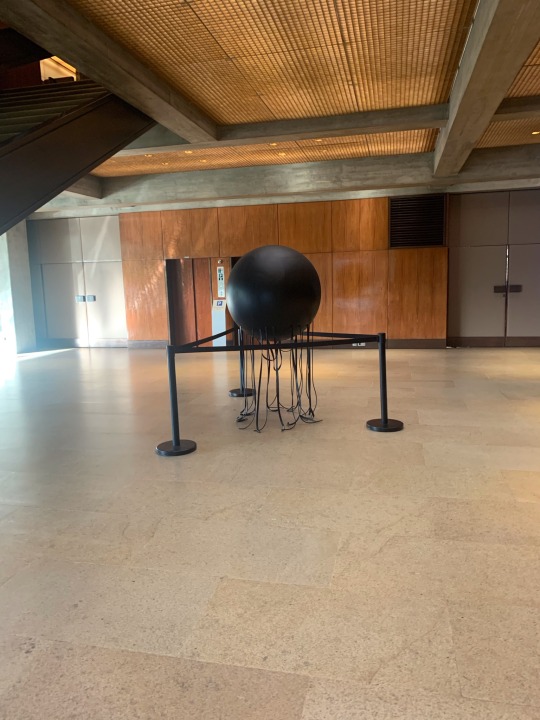
0 notes
Text
Semester 1 Week 8, 3 Oct 2022
In the eighth week of my learning, we explored the works of Richard Strauss and Olivier Messiaen, analysing Death & Transfiguration and Turangalila, respectively. In addition, we delved into the world of Messiaen modes, a unique collection of musical scales that can be used to modulate to different keys. We were taught how to utilise these scales across different verticals and create our own scales using polychords, which are six-note scales consisting of two triads. The use of these scales allows for a more intricate and complex harmonic progression in compositions. By the end of the week, we had gained a deeper understanding of how to use scales to modulate to different keys and how to incorporate them into our own musical arrangements. This week's lessons provided valuable insights into the techniques used by renowned composers, which will allow us to create more unique and interesting musical compositions.
youtube
0 notes
Text
Semester 1 Week 8
During the eighth week of my learning, we analyzed Richard Strauss' Death & Transfiguration and/or Turangalila by Olivier Messiaen. In addition, we were introduced to Messiaen modes, a collection of musical scales that can be used to modulate to different keys. We learned how to use these scales over different verticals and create our own scales using polychords, which are six-note scales. By the end of the week, we had developed a deeper understanding of how to use scales to modulate to different keys and had learned new techniques for creating unique and interesting musical compositions. Overall, this week's lessons provided me with valuable insights into the techniques used by great composers and taught me how to apply these techniques to my own musical compositions.
0 notes
Quote
Messiaen – La Transfiguration de Notre-Seigneur Jésus-Christ (1969) Today is the Western Christian feast day of the Transfiguration, a miracle in the Gospels where Jesus led some of the disciples up a mountain to pray, only for him to become luminous, be situated between Elijah and Moses, and a voice from the heavens calls Jesus…
Messiaen – La Transfiguration de Notre-Seigneur Jésus-Christ (1969) Today is the Western Christian feast day of the Transfiguration, a miracle in the Gospels where Jesus led some of the disciples up a mountain to pray, only for him to become luminous, be situated between Elijah and Moses, and a voice from the heavens calls Jesus…
0 notes
Quote
Messiaen – La Transfiguration de Notre-Seigneur Jésus-Christ (1969) Today is the Western Christian feast day of the Transfiguration, a miracle in the Gospels where Jesus led some of the disciples up a mountain to pray, only for him to become luminous, be situated between Elijah and Moses, and a voice from the heavens calls Jesus…
Messiaen – La Transfiguration de Notre-Seigneur Jésus-Christ (1969) Today is the Western Christian feast day of the Transfiguration, a miracle in the Gospels where Jesus led some of the disciples up a mountain to pray, only for him to become luminous, be situated between Elijah and Moses, and a voice from the heavens calls Jesus…
0 notes
Quote
Messiaen – La Transfiguration de Notre-Seigneur Jésus-Christ (1969) Today is the Western Christian feast day of the Transfiguration, a miracle in the Gospels where Jesus led some of the disciples up a mountain to pray, only for him to become luminous, be situated between Elijah and Moses, and a voice from the heavens calls Jesus…
Messiaen – La Transfiguration de Notre-Seigneur Jésus-Christ (1969) Today is the Western Christian feast day of the Transfiguration, a miracle in the Gospels where Jesus led some of the disciples up a mountain to pray, only for him to become luminous, be situated between Elijah and Moses, and a voice from the heavens calls Jesus…
0 notes
Quote
Messiaen – La Transfiguration de Notre-Seigneur Jésus-Christ (1969) Today is the Western Christian feast day of the Transfiguration, a miracle in the Gospels where Jesus led some of the disciples up a mountain to pray, only for him to become luminous, be situated between Elijah and Moses, and a voice from the heavens calls Jesus…
Messiaen – La Transfiguration de Notre-Seigneur Jésus-Christ (1969) Today is the Western Christian feast day of the Transfiguration, a miracle in the Gospels where Jesus led some of the disciples up a mountain to pray, only for him to become luminous, be situated between Elijah and Moses, and a voice from the heavens calls Jesus…
0 notes
Audio
Former president and executive director of the New York Philharmonic, Zarin Mehta, grew up in 1940’s Bombay before it became the booming city of Mumbai. In Mehta’s memory, Bombay was more like a colonial fishing village.
Mehta talks with Alec about his father, who founded the Bombay Symphony Orchestra, his brother Zubin, and the realities of running a major arts organization in New York, saying that, “in the United States one does not look to the state for support of the arts.” Alec also speaks with Mehta's wife, Carmen, and she offers her own insights into his success.
READ | Interview Transcript
Music excerpts included in Here’s the Thing’s conversation with Zarin Mehta:
Mozart: Symphony No. 41, "Jupiter" (Lorin Maazel/NYP from 2006 DG Download #1)
Ravel: Daphnis et Chloe, Part 3 - 3eme tableau - Teil 3, Orchestre symphonique du Montreal / Choeur de l'Orchestre symphonique de Montreal; Charles Dutoit, (Decca Record Company, Ltd / London (Polygram Classics)
Beethoven: Overture to Egmont from Alan Gilbert: The Inaugural Season iTunes Pass, release 5 (Alan Gilbert/NYP)
Bach: The Well-Tempered Clavier, Book 1, Prelude & Fugue #1 In C, BWV 846.R; Andras Schiff, Piano; Decca Record Company, Ltd / London (Polygram Classics)
Schubert: Songs for Mezzo-Soprano & Orchestra (Anne-Sophie von Otter, mezzo/NYP/Alan Gilbert from 2011-12 iTunes Pass, release 4
Messiaen: Coleurs de la cite celeste (Colors of the celestial city) (Emmanuel Ax, piano/NYP/Alan Gilbert from 2010-12 iTunes Pass, release
Brahms: A German Requiem (Masur/NYP as recorded following the events of 9/11, Heidi Grant Murphy, soloist) (from NYP broadcast archives, 2001 "special" and NYP 11-50)
Strauss: Tod und Verklarung (Death and Transfiguration) from 2005; Lorin Maazel, conductor (from NYP broadcast archives, 06-03)
Thanks to the New York Philharmonic for generous use of archival material.
#Here's the Thing#Alec Baldwin#Zarin Mehta#New York Philharmonic#Bombay Symphony Orchestra#Mozart#Ravel#Beethoven#Bach#Schubert#Messiaen#Brahms#Strauss
0 notes
Text
affirmation (lowercase)
Loneliness is not the worst thing that can happen to a woman. What is worse than loneliness: the feeling of life on automatic. Wherein one moves from need to need, the needs of others, or those who one “loves,” as though one were an organic machine programmed to play a never-ending part.
I wish I knew why women so often fall into this. My instincts say that it is more complicated than an interconnected and omnipresent web of slothful advertisements, habitual cultural behaviors and beliefs, and the simple, nearly innocent lies which make up our political fabric. My instincts lead me to wonder what might be beyond all this, perhaps something in woman herself, which delights to bend and dance and conquer, and forget herself in that conquering.
In Shaiva Tantra, Shiva is often depicted with four arms: one for creation, one for destruction. One for coming into the light, and one for occlusion, or forgetting. This last arm, the forgetting arm, is what interests me the most.
There is one reading of grace as reduction, to which I have been attracted to for many years. Grace is the reduction of the monstrous everythingness of God into the comprehensible, the everyday, the silly, the forgettable. From Olivier Messiaen’s inimitable dissonance into full harmony, a E major chord at the end of each torturous passage in La Transfiguration. This E Major is the principle underneath narrative as well: narrative resolution. The spirit’s resolution inside itself, as itself: not destroying anything, but forgetting.
Forgetting is some lynchpin, somewhere, of narrative.
Today, when I think of the best work of my life, I think of that summer in Paris in which I drifted, fully awake and alive, through the museums and arcades of that dusty, sleepy, inimitable city. That city which pulses and breathes with life even in its decades-long slumber; that city whose sleep might still be described as muscular, rogueish, tactical. A tactical sleep. This long and tactical sleep of which I have been a part may finally be coming to an end.
I have used others and I have hurt others. I have drawn blood inside myself also. I have run until I tasted blood; biked too. I had admired where I should have only watched. And yet I, too, can come to some fountain, even if just the fountain of the world, and see some reflection which surprises me: not with beauty, but with recognition. That we can see ourselves in the world, despite everything, is the first and last gift of being alive.
3 notes
·
View notes
Text

identiteit:
-Olivier Messiaen -Franse nationaliteit -geboren: Avignon 10 december 1908 -gestorven: Parijs 27 april 1992
-belangrijke composities: Turangalîla-symfonie, La Transfiguration de Notre Seigneur Jésus-Christ, Saint-François d'Assise
-https://youtu.be/Hp2TY5zZnxc = Pièce pour le tombeau de Paul Dukas - Deze compositie gaat over een eerbetoon van iemand die is overleden -muzikale bouwstenen:ritme klankkleur: het heeft steeds hetzelfde ritme en de klankkleur is ook belangrijk want het geeft een bepaalde sfeer namelijk iemand is gestorven - ik vind het fragment wel goed want je hoort duidelijk dat hij het heeft geschreven voor iemand die is gestorven.
-bronvermelding: wikipedia,youtube, www.golfbrekers.be
0 notes
Note
HI
I guess my question to you is what classical piece gives to you or makes the largest emotional response ?
I only ask because of the millions of times I have listened to Beethoven's Symphony #9(the whole thing)
had a huge response to it recently because of my mental issues that has happened to me in the past months :(
I guess I have grown a greater appreciation for Classical music and it's healing powers :)
Sorry for the way too much information ;) Have an excellent day :)
that's a tough question, what's given me emotional response has changed over the years.
Mahler - Symphony no. 8. Really any of Mahler's symphonies can go here, he's a very "emotional" composer. I only chose the 8th because of the amazing moments that happen across its runtime, and its melodies always tug at my heart
Schubert - Sonata in A Major D.664 mov.2 Andante. I also could have put in any Schubert piece. While Mahler is large and bombastic, Schubert is way more subtle. And when he's at his most delicate, it sounds like the sublimity that people gush over Mozart for. The slow movement of this sonata is short but pretty moving
Chopin - Prelude op.28 no.13. Posted about this one recently, but it's a prelude that I hadn't really thought about much listening through the set since high school. Only this past couple months did I really listen to it and feel mored by the atmosphere it creates
Schoenberg - Transfigured Night. The darkness of the strings moving around in murky harmonies eventually turns into shimmering stars.
Messiaen - Le banquet céleste. For organ, has a gorgeous meditative air to it
37 notes
·
View notes
Text
ESA-PEKKA SALONEN

THE COMPLETE SONY RECORDINGS
Una extensa recopilación reúne las grabaciones del gran gran director Esa-Pekka Salonen. Hoy a la venta.
Una caja con 61 CDs recoge las grabaciones completas para Sony del director y compositor finlandés Esa Pekka-Salonen (1958), una figura vital en la música contemporánea. Se trata de la recopilación más grande realizada sobre Pekka-Salonen hasta el momento y en ella queda plasmada la estrecha vinculación del músico con distintas orquestas.
En 23 de los discos de esta colección dirige a la Filarmónica de Los Angeles, de la que fue director principal durante 17 años. En otros 12 discos dirige a la Sinfónica de la Radio Sueca, en la que ejerció de conductor principal entre 1985 y 1994. Y, finalmente, en 14 discos dirige a la Philharmonia de Londres, en la que es el director principal desde 2008.
El primer ciclo de sinfonías y conciertos de Nielsen con la Sinfónica de la Radio Sueca tiene aquí su primer lanzamiento como conjunto completo de ocho discos. Otros seis discos muestran la destreza de de Salonen para dirigier obras de su compatriota Sibelius, con piezas como la Quinta Sinfonía y el enorme Kullervo.
Gramophone describió la grabación de Salonen de Des Canyons aux étoiles, de Messiaen, con la Sinfonietta de Londres como “un componente esencial de cualquier biblioteca de la música del siglo XX”. Sus grabaciones de Stravinsky no son menos significativas y están representadas aquí desde los primeros ballets hasta la última Cantata. También son destacables las grabaciones de obras de Ligeti con la Philharmonia y diversas piezas de Lutolawski, incluida la grabación de la Tercera Sinfonía por la que ganó un premio Grammy.
“Lo que ha hecho de las grabaciones de Salonen algo tan especial ha sido, no sólo su gran destreza técnica como conductor sino su visión de la música como un talentoso compositor”, escribió Gramophone deLA Variations, un álbum con música compuesta por el propio Salonen. Él aporta esta visión no sólo en el repertorio mencionado anteriormente, sino también en la música de Saariaho, Richard Strauss, Dallapiccola y Debussy, entre otros.
A lo largo de esta extensa colección es acompañado por destacados solistas como Emanuel Axe, Gidon Kremer, Wynton Marsalis, Dawn Upshaw y Yefim Bronfman, cuya grabación de Bartók con Salonen ganó otro Grammy. Adem��s, también se incluye un álbum de música pop de Anders Hillborg, cantado por la sueca Eva Dahlgren, porque Salonen sigue siendo un músico lleno de sorpresas.
CONTENIDO DE LA CAJA
DISCO 1: SK89012
Bach: Toccata & Fugue in D Minor, BWV 565
Bach: Fantasy & Fugue in C minor, BWV 537
Bach: Ricercar No. 2 from "The Musical Offering" BWV 1079
Bach: Prelude & Fugue in E-flat Major, BWV 552 "St. Anne"
Bach: Fugue in G minor, "Little" BWV 578
Bach: Suite in Four Movements for Organ, Harpsichord & Orchestra (arrangements from selections of Bach's Orchestral Suites Nos. 2 & 3)
DISCO 2: SK62598
Bartók: Concerto for Orchestra
Bartók: Music for Strings, Percussion and Celesta, Sz. 106
DISCO 3: SK66718
Bartók: Concerto for Piano and Orchestra No. 2 (1930-1931)
Bartók: Concerto for Piano and Orchestra No. 3 (1945)
Bartók: Concerto for Piano and Orchestra No. 1 (1926)
DISCO 4: SK63301
Bruckner: Symphony No. 4 in E-flat Major "Romantic"
DISCO 5: SK63010
Corigliano: The Red Violin
DISCO 6: SK68323
Dallapiccola: Il Prigioniero (The Prisoner)
Dallapiccola: Canti di prigionia (Songs of Imprisonment)
DISCO 7: SK62599
Debussy: Images pour Orchestre
Debussy: Prélude à l'après-midi d'un faune
Debussy: La Mer
DISCO 8: SK58952
Debussy: Nocturnes
Debussy: La Damoiselle élue
Debussy: Le Martyre de Saint Sébastien
DISCO 9: M 44528
Grieg: Peer Gynt, Op. 23
DISCO 10: SK45972
Haydn: Symphony No 82 in C Major, Hob. I: 82 "The Bear"
Haydn: Symphony No. 78 in C Minor, Hob. I: 78
Haydn: Symphony No. 22 in E-flat Major, Hob I: 22 "The Philosopher"
DISCO 11: SK62700
Herrmann: The Man Who Knew Too Much: Prelude
Herrmann: Psycho: A Suite for Strings
Herrmann: Marnie: Suite
Herrmann: North by Northwest: Overture
Herrmann: Vertigo Suite
Herrmann: Torn Curtain
Herrmann: Fahrenheit 451: Suite for Strings, Harps, and Percussion
Herrmann: Taxi Driver: A Night-Piece for Orchestra with obbligato Alto Saxophone
DISCO 12: 74321313102
Hillborg: Lava
Hillborg: Stenmannen
Hillborg: När en röd ros slår ut doftar hela skogen
Hillborg: Jorden är ett litet rum
Hillborg: En gul böjd banan
Hillborg: Kväll
Hillborg: Du som älskar
Hillborg: Innan kärleken kom
Hillborg: Vild i min mun
DISCO 13: SK64087
Hindemith: Symphonic Metamorphoses on Themes of Carl Maria von Weber
Hindemith: Theme and Variations "The Four Temperaments"
Hindemith: Symphony "Mathis der Maler"
DISCO 14: SK64140
Larsson: Förklädd Gud, Op. 24
Larsson: Pastoralsvit, Op. 19
Larsson: Violinkonsert, Op. 42
DISCO 15/16: S2K623122
Ligeti: Le Grand Macabre (1997 Version)
DISCO 17: SK62311
Ligeti: Nonsense Madrigals
Ligeti: Mysteries of the Macabre
Ligeti: Aventures
Ligeti: Nouvelles Aventures
Ligeti: Der Sommer
Ligeti: Három Weöres dal
Ligeti: Öt Arany dal
Ligeti: Négy lakodalmi tánc
DISCO 18: SK89810
Lindberg: Cantigas
Lindberg: Cello Concerto
Lindberg: Parada
Lindberg: Fresco
DISCO 19: SK53289
Schoenberg: Concerto for Piano and Orchestra, Op. 42
Liszt: Concerto No. 2 for Piano and Orchestra in A Major
Liszt: Concerto No. 1 in E-flat Major for Piano and Orchestra, S. 124
DISCO 20: SK67189
Lutoslawski: Fanfare for Los Angeles Philharmonic (1993)
Lutoslawski: Concerto for Piano & Orchestra (1987)
Lutoslawski: Chantefleurs et Chantefables - Song Cycle for Soprano & Orchestra
Lutoslawski: Symphony No. 2
DISCO 21/22: 88765440832
Lutoslawski: Fanfare for Los Angeles Philharmonic
Lutoslawski: Symphony No. 1
Lutoslawski: Symphony No. 4
Lutoslawski: Symphony No. 3
Lutoslawski: Les Espaces du Sommeil (World Premiere Recording)
DISCO 23/24: S2K60250
Mahler: Symphony No. 3 in D Minor
DISCO 25: SK48380
Mahler: Symphony No. 4 in G Major
DISCO 26: SK60646
Mahler: Das Lied von der Erde
DISCO 27/28: S2K89817
Marsalis: All Rise
DISC 29: I2M 42126
Messiaen: Turangalîla-Symphonie
DISC 30/31: M2K44762
Messiaen: Des canyons aux étoiles for Piano, Horn and Orchestra (1970-74)
Messiaen: Oiseaux exotiques for Piano, 11 Winds, Xylophone, Glockenspiel and 2 Percussion (1955-56)
Messiaen: Couleurs de la cité céleste for Piano, 13 Winds, Xylophone, Xylorimba, Marimba and 4 Percussion (1963)
DISC 32: M 42321
Nielsen: Symphony No. 1 in G Minor, Op. 7
Nielsen: Little Suite in A Minor, Op. 1
DISC 33: M 44934
Nielsen: Symphony No. 2, Op. 16 "The Four Temperaments"
Nielsen: Pan and Syrinx, Op. 49
Nielsen: Aladdin Suite, Op. 34
DISC 34: SK46500
Nielsen: Symphony No. 3, Op. 27 "Sinfonia Espansiva"
Nielsen: Symphony No. 6 "Sinfonia Semplice"
DISC 35: IM 42093
Nielsen: Symphony No. 4, Op. 29, "The Inextinguishable"
Nielsen: Helios Overture, Op. 17
DISC 36: M 44547
Nielsen: Symphony No. 5, Op. 50 (Beginning)
Nielsen: Masquerade, FS 39 (Excerpts)
DISC 37: M 44548
Sibelius: Concerto in D Minor for Violin and Orchestra, Op. 47
Nielsen: Violin Concerto, Op. 33
DISC 38: SK53276
Nielsen: "Saul and David" (Act II)
Nielsen: Concerto for Clarinet and Orchestra, Op.57
Nielsen: En fantasirejse til Faeroerne (An Imaginary Journey to the Faeroe Islands) - Rhapsodic Overture
Nielsen: Concerto for Flute and Orchestra
Nielsen: Fynsk Forar, Op.42 (Springtime on Funen) - Lyric Humoresque for Soloists, Chorus and Orchestra
Nielsen: Den blinde spillemand - The Blind Musician
Nielsen: De gamle - The Old People
Nielsen: Dansevisen - Dance ballad
DISC 39: M 42662
Prokofiev: Romeo and Juliet, Op. 64 (Excerpts)
DISC 40: SK53969
Prokofiev: Concerto No. 1 in D Major for Violin and Orchestra, Op. 19
Prokofiev: Concerto No. 2 in G Minor for Violin and Orchestra, Op. 63
Stravinsky: Concerto in D for Violin and Orchestra
DISC 41: SK47183
Rachmaninoff: Concerto for Piano and Orchestra No. 2 in C Minor, Op. 18
Rachmaninoff: Concerto for Piano and Orchestra No. 3 in D Minor, Op. 30
DISC 42: SK60676
Revueltas: Sensemayá
Revueltas: Ocho por Radio
Revueltas: La Noche de los Mayas
Revueltas: Homenaje a Federico Garcia Lorca for Chamber Orchestra
Revueltas: Ventanas for Large Orchestra
Revueltas: First Little Serious Piece
Revueltas: Second Little Serious Piece. Tempo di Valse - Lento
DISC 43: SK60817
Saariaho: Graal Théâtre
Saariaho: Château de l'âme
Saariaho: Amers
DISC 44: SK89158
Salonen: LA Variations
Salonen: Five Images after Sappho
Salonen: Giro for Orchestra
Salonen: Mania for Violoncello Solo and Ensemble
Salonen: Gambit for Orchestra
DISC 45: SK62725
Schoenberg: Verklärte Nacht (Transfigured Night), Op. 4 (1943 Revision for String Orchestra)
Schoenberg: String Quartet No. 2, Op. 10
DISC 46: SK60677
Shostakovitch: Concerto No. 1 in C minor for Piano, Trumpet and Orchestra, Op. 35
Shostakovitch: Concerto No. 2 in F Major for Piano and Orchestra, Op. 102
Shostakovitch: Quintet in G minor for Piano and Strings, Op. 57 (1940)
DISC 47: M 42366
Sibelius: Symphony No. 5 in E-Flat Major, Op. 82
Sibelius: Pohjola's Daughter for Orchestra, Op. 49
DISC 48: SK48067
Sibelius: Lemminkainen Suite, Op. 22
Sibelius: En Saga for Orchestra, Op. 9
DISC 49: SK52563
Sibelius: Kullervo, Op. 7
DISC 50: SK65949
Sibelius: Concerto for Violin and Orchestra in D Minor, Op. 47
Goldmark: Violin Concerto No. 1 in A Minor, Op. 28
DISC 51: M 44702
Strauss, R.: Metamorphosen
Strauss, R.: Duet Concertino for Clarinet and Bassoon with String Orchestra and Harp
Strauss, R.: Prelude to Capriccio, Op. 85
DISC 52: SK53274
Stravinsky: Petrushka - Burlesque in Four Scenes (1947 Version)
Stravinsky: Orpheus - Ballet in three scenes
DISC 53: M 44917
Stravinsky: L'Oiseau de Feu (The Firebird)
Stravinsky: Jeu de cartes
DISC 54: SK45796
Stravinsky: The Rite of Spring
Stravinsky: Symphony in Three Movements
DISC 55: SK45965
Stravinsky: Pulcinella - Ballet for small Orchestra with three Solo Voices (Revised Edition 1965)
Stravinsky: Ragtime for Eleven Instruments (1918)
Stravinsky: Renard the Fox - A Burlesque Tale in Song and Dance
Stravinsky: Octet for Wind Instruments (Revised 1952 Version)
DISC 56: SK45797
Stravinsky: Capriccio for Piano and Orchestra (1949 Version)
Stravinsky: Symphonies of Wind Instruments (1947 Version)
Stravinsky: Concerto for Piano and Wind Instruments (1950 Version)
Stravinsky: Movements for Piano and Orchestra
DISC 57: SK46667
Stravinsky: Apollon Musagète - Ballet in Two Scenes (Revised Version, 1947)
Stravinsky: Concerto in D for String and Orchestra (Revised Version of 1946)
Stravinsky: Cantata
DISC 58: SK48057
Stravinsky: Oedipus Rex
DISC 59: SK46720
Takemitsu: To the Edge of Dream for Guitar and Orchestra
Takemitsu: Folios for Guitar
Takemitsu: Toward the Sea for Alto Flute and Guitar
Takemitsu: Four Songs from 12 Songs for Guitar
Takemitsu: Vers, L'Arc-en-Ciel, Palma for Oboe d'amore, Guitar and Orchestra
DISC 60: IM 42096
Tomaso: Concerto for Trumpet and Orchestra (1949)
Jolivet: Concertino for Trumpet, String Orchestra and Piano (1948)
Jolivet: Concerto No. 2 for Trumpet and Orchestra (1954)
DISC 61: SK46668
Alfen: Swedish Rhapsody No. 1 for Orchestra, Op. 19 "Midsommarvaka" (1903)
Sibelius: Valse triste from "Kuolema", Op. 44
Grieg: Sigurd Jorsalfar, Op. 56
Alfen: Vallflickans Dance (Dance of the Shepherdess from the ballet-pantomime Bergakungen, Op. 37)
Leifs: Geysir - Orchestral Prelude, Op. 51
Nielsen: Maskarade, Op. 39 (Excerpt)
Järnefelt: Berceuse for Small Orchestra (1904)
Sibelius: Finlandia for Orchestra, Op. 26
Official Artist Website: www.esapekkasalonen.com
Official Facebook Page:www.facebook.com/esapekkasalonen
Official Twitter Page: twitter.com/esapekkasalonen
0 notes
Text
25 DE ABRIL: COMEMORAÇÕES EM TEMPO DE AMEAÇAS,; PLANO DE DISTRACÇÃO DA SEMANA AOS 55 DIAS DO DO LUTO- O NAVIO FANTASMA DE WAGNER A 26 NO CCB, A TRANSFIGURAÇÃO DE MESSIEN NA GULBENKIAN A 27 , VELOSO SALGADO NO MNAC E “DIAS LINDOS” DE BECKETT NO S.LUIZ A 28 E “O FILHO“ DE FLORIAN ZELLER NO TEATRO ABERTO A 29 : nesta data triste ver os valores do 25 de Abril cada vez mais ameaçados por gerações que não o viveram e pelo crescendo dos populismos . Eu não esqueço como escreveu Sofia o “O dia inicial inteiro e limpo, onde emergimos da noite e do silêncio…nem o herói maltratado que saiu à rua . Amanhã irei ao CCB com sobrinhos queridos e a Renata no lugar da mãe assistir à co-produção do TNSC da ópera O Navio Fantasma de Richard Wagner («Der fliegende Holländer» no título original) que estreou em 1843. A nova produção é assinada por Max Hoehn, No dia seguinte estarei no concerto da “nossa” assinatura onde o Coro e a Orquestra Gulbenkian, sob a direção do maestro Myung-Whun Chung, interpretam uma das mais impressionantes criações religiosas do compositor Olivier Messiaen “La Transfiguration de Notre Seigneur Jésus-Christ”.A peça, estreada em 1969, foi uma encomenda da Fundação . Dia 28 será tempo de ir ao Chiado ver a exposição de Veloso Salgado no MNAC e no S. Luiz Chucha Carvalheiro interpretar Lindos Dias! (Happy Days) de Samuel Beckett. Dia 29 na companhia dos meus amigos Calpi irei ver no Teatro Aberto “ O Filho” de Florian Zeller .E o combate aos 55 dias de uma ausência terrível …

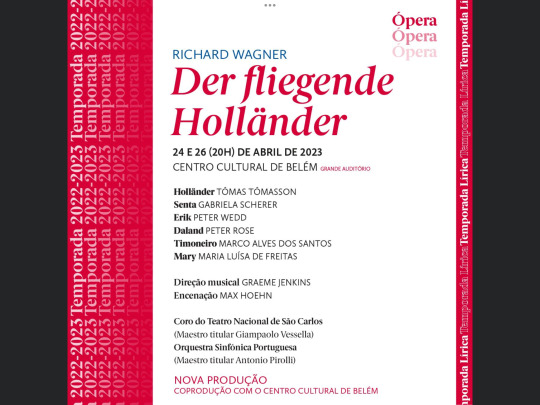


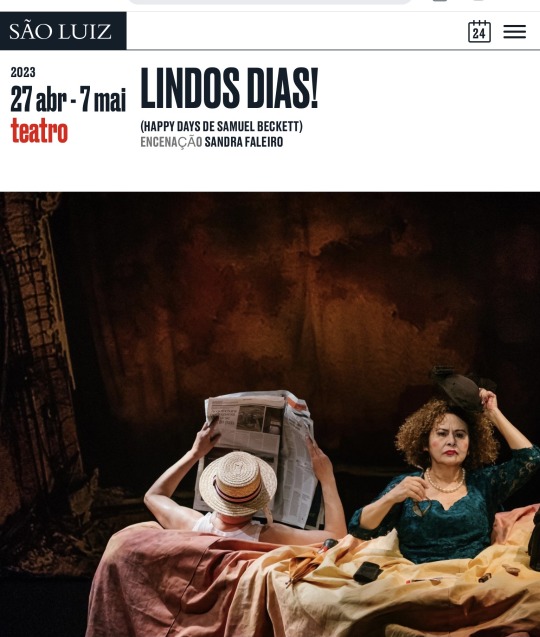
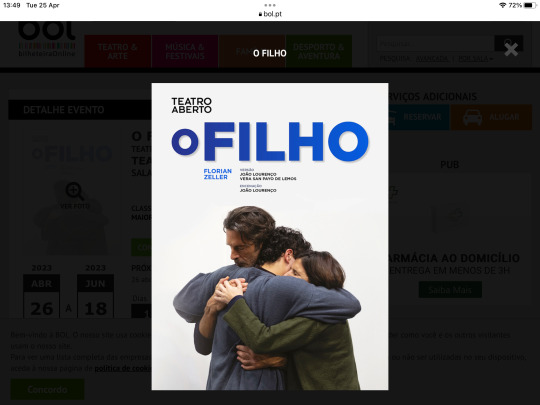
0 notes